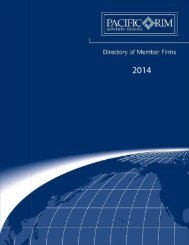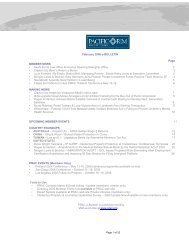enefit. The Commissioner can <strong>the</strong>n impose withhold<strong>in</strong>g taxcalculated on <strong>the</strong> tax benefit <strong>to</strong>ge<strong>the</strong>r with possible additionaltax <strong>of</strong> 25 percent or 50 percent depend<strong>in</strong>g upon whe<strong>the</strong>r <strong>the</strong>payer has a reasonably arguable case.A specific anti-avoidance provision deems amounts <strong>of</strong> <strong>in</strong>terestpaid by an <strong>Australia</strong>n resident through a tax-exempt <strong>in</strong>terposedentity <strong>to</strong> a non-resident recipient, <strong>to</strong> have been paid by <strong>the</strong>resident directly <strong>to</strong> a non-resident. Payments made <strong>in</strong> such amanner are <strong>the</strong>refore be subject <strong>to</strong> IWT.5.3.7 Commentary on <strong>the</strong> revised IWT exemptionsWhile <strong>the</strong> revised IWT exemptions provide a number <strong>of</strong> positivereforms for <strong>the</strong> securitisation <strong>in</strong>dustry, a number <strong>of</strong> difficultieshave been encountered with <strong>the</strong> implementation <strong>of</strong> <strong>the</strong>provisions <strong>in</strong> practice.Causal connection between <strong>the</strong> <strong>of</strong>fer<strong>in</strong>g and issue <strong>of</strong> securitiesSection 128F(3) provides that <strong>the</strong> issue <strong>of</strong> <strong>the</strong> relevantdebentures must result from <strong>the</strong> debentures be<strong>in</strong>g <strong>of</strong>fered by one<strong>of</strong> <strong>the</strong> means set out <strong>in</strong> <strong>the</strong> section. There must <strong>the</strong>refore be acausal connection between <strong>the</strong> method <strong>of</strong> <strong>of</strong>fer<strong>in</strong>g and <strong>the</strong> actualissue <strong>of</strong> <strong>the</strong> debentures. Where debentures are issued which donot satisfy this causal connection, <strong>the</strong>n <strong>the</strong>y will not, strictlyspeak<strong>in</strong>g, be eligible for <strong>the</strong> IWT exemption.For example, say debentures were <strong>of</strong>fered <strong>to</strong> 10 sophisticated<strong>in</strong>ves<strong>to</strong>rs <strong>in</strong> <strong>the</strong> manner contemplated by section 128F(3)(a) (seeabove), but those debentures were actually issued <strong>to</strong> o<strong>the</strong>rs(because <strong>the</strong> 10 sophisticated <strong>in</strong>ves<strong>to</strong>rs did not take up <strong>the</strong>ir<strong>of</strong>fers). In <strong>the</strong>se circumstances, it is difficult <strong>to</strong> conclude that <strong>the</strong>debentures were issued as a result <strong>of</strong> be<strong>in</strong>g <strong>of</strong>fered <strong>to</strong> <strong>the</strong> 10sophisticated <strong>in</strong>ves<strong>to</strong>rs. They were issued as a result <strong>of</strong> be<strong>in</strong>g<strong>of</strong>fered <strong>to</strong> <strong>the</strong> o<strong>the</strong>rs who <strong>the</strong>n accepted <strong>the</strong>ir <strong>of</strong>fers. Strictlyspeak<strong>in</strong>g, <strong>the</strong>refore, even though <strong>the</strong> debentures were <strong>in</strong>itially<strong>of</strong>fered <strong>in</strong> a way comply<strong>in</strong>g with section 128F(3)(a), <strong>the</strong> causalconnection requirement was not satisfied and <strong>the</strong> debentures donot qualify for <strong>the</strong> IWT exemption.There are also o<strong>the</strong>r potential problems posed by <strong>the</strong> causalconnection requirement. Where debentures are listed for <strong>the</strong>purposes <strong>of</strong> section 128F(3)(c) (eg. on <strong>the</strong> London or Luxemburgs<strong>to</strong>ck exchanges), it may be difficult <strong>to</strong> conclude that <strong>the</strong>debentures were issued as a result <strong>of</strong> <strong>the</strong> list<strong>in</strong>g. List<strong>in</strong>g is part <strong>of</strong><strong>the</strong> overall process, and is perhaps a condition precedent <strong>to</strong> <strong>the</strong>issue, but usually it is one <strong>of</strong> many conditions precedent. Also,where debentures are <strong>of</strong>fered for sale on Reuters or Bloombergsfor <strong>the</strong> purposes <strong>of</strong> section 128F(3)(d), but are acquired bypersons as a result <strong>of</strong> direct <strong>of</strong>fers by way <strong>of</strong> telephone whowere unaware <strong>of</strong> <strong>the</strong> electronic <strong>of</strong>fer (eg. because <strong>the</strong>y do notreceive Reuters or Bloombergs), <strong>the</strong>n it may be said that <strong>the</strong>debentures were not issued as a result <strong>of</strong> “negotiations be<strong>in</strong>g<strong>in</strong>itiated publicly <strong>in</strong> electronic form”.In response <strong>to</strong> <strong>the</strong>se difficulties, <strong>the</strong> <strong>Australia</strong>n Taxation Office(ATO) issued Taxation Determ<strong>in</strong>ation TD 1999/8. In <strong>the</strong>Determ<strong>in</strong>ation, <strong>the</strong> ATO held that it would adm<strong>in</strong>ister section128F(3) on <strong>the</strong> basis that a debenture will be taken <strong>to</strong> haveresulted from be<strong>in</strong>g <strong>of</strong>fered for issue if <strong>the</strong> debenture satisfiesone <strong>of</strong> <strong>the</strong> paragraphs set out <strong>in</strong> section 128F(3) (ie. <strong>in</strong> effect, <strong>the</strong>statu<strong>to</strong>ry causal connection requirement can be ignored).Dealer compliance with <strong>the</strong> IWT exemption requirementsIdeally, an issuer will wish its dealer panel <strong>to</strong> covenant that <strong>the</strong>ywill <strong>of</strong>fer and issue <strong>the</strong> debentures <strong>in</strong> a manner that complieswith <strong>the</strong> IWT exemption requirements. Some dealers areprepared <strong>to</strong> do this; however o<strong>the</strong>rs ei<strong>the</strong>r give covenants thats<strong>to</strong>p short <strong>of</strong> full compliance or are not prepared <strong>to</strong> give anyundertak<strong>in</strong>gs as <strong>to</strong> <strong>the</strong> manner <strong>of</strong> <strong>of</strong>fer and issue, argu<strong>in</strong>g that<strong>the</strong>y should not be required <strong>to</strong> change <strong>the</strong>ir standard proceduresand that <strong>the</strong> issuer should satisfy itself that <strong>the</strong>y comply with <strong>the</strong>IWT exemption requirements. In this regard, <strong>the</strong>re are a number<strong>of</strong> provisions that are <strong>of</strong> regular concern <strong>to</strong> dealers. If atransaction is rely<strong>in</strong>g on section 128F(3)(a) (through section128F(3)(e)), <strong>the</strong> issuer will want <strong>to</strong> know that a dealer’s clients<strong>to</strong> whom <strong>the</strong> securities are be<strong>in</strong>g <strong>of</strong>fered are “carry<strong>in</strong>g on abus<strong>in</strong>ess <strong>of</strong> provid<strong>in</strong>g f<strong>in</strong>ance, or <strong>in</strong>vest<strong>in</strong>g or deal<strong>in</strong>g <strong>in</strong>securities, <strong>in</strong> <strong>the</strong> course <strong>of</strong> operat<strong>in</strong>g <strong>in</strong> f<strong>in</strong>ancial markets”.Also an issuer will want an assurance that none <strong>of</strong> <strong>the</strong>se<strong>in</strong>ves<strong>to</strong>rs are “associates” <strong>of</strong> each o<strong>the</strong>r for <strong>the</strong> purposes <strong>of</strong>section 128F(3)(a) or, generally, an associate <strong>of</strong> <strong>the</strong> issuer for<strong>the</strong> purposes <strong>of</strong> section 128F(5).While one can be sympa<strong>the</strong>tic <strong>to</strong> <strong>the</strong> position <strong>of</strong> <strong>in</strong>ternationaldealers, if issuers do not receive <strong>the</strong> requisite assurances from<strong>the</strong>m, <strong>the</strong>y are placed <strong>in</strong> a very difficult position.They have no certa<strong>in</strong>ty that <strong>the</strong>ir securities qualify for <strong>the</strong> IWTexemption. Under <strong>the</strong> self assessment system, it may be manyyears before <strong>the</strong> Commissioner <strong>of</strong> Taxation concludes that <strong>the</strong>debentures did not so qualify, at which po<strong>in</strong>t <strong>the</strong> securitisationvehicle is likely <strong>to</strong> have accrued a substantial unfunded <strong>in</strong>terestwithhold<strong>in</strong>g tax liability.5.3.8 ConclusionWhile <strong>the</strong>re are some issues <strong>in</strong> relation <strong>to</strong> <strong>the</strong> practicalimplementation <strong>of</strong> <strong>the</strong> IWT exemptions <strong>in</strong> section 128F, overall<strong>the</strong>y have opened up <strong>the</strong> <strong>in</strong>ternational capital markets <strong>to</strong><strong>Australia</strong>n securitisers.35
365.4 Debt/equity rulesDivision 974 <strong>of</strong> <strong>the</strong> 1997 Tax Act conta<strong>in</strong>s rules which def<strong>in</strong>e <strong>the</strong>debt/equity borderl<strong>in</strong>e for tax purposes.Where notes used <strong>to</strong> fund a securitisation vehicle are regardedas equity for tax purposes, <strong>in</strong>terest on <strong>the</strong> notes is not deductiblewhich may disrupt <strong>the</strong> tax neutrality <strong>of</strong> <strong>the</strong> securitisation vehicle.The notes will only be treated as equity <strong>in</strong>terest where <strong>the</strong>y beara return which is cont<strong>in</strong>gent on <strong>the</strong> economic performance <strong>of</strong> <strong>the</strong>issuer or <strong>the</strong>y are convertible <strong>in</strong><strong>to</strong> equity <strong>in</strong>terests.5.5 Th<strong>in</strong> capitalisationDivision 820 <strong>of</strong> <strong>the</strong> 1997 Tax Act conta<strong>in</strong>s <strong>Australia</strong>’s th<strong>in</strong>capitalisation rules and applies <strong>to</strong> <strong>Australia</strong>n resident entitiesthat are foreign controlled, <strong>to</strong> <strong>Australia</strong>n controllers <strong>of</strong> foreignentities and <strong>to</strong> <strong>Australia</strong>n entities that carry on bus<strong>in</strong>ess throughan overseas branch (as well as certa<strong>in</strong> foreign entities).There is an exemption from <strong>the</strong> th<strong>in</strong> capitalisation measures forcerta<strong>in</strong> special purpose entities. In order <strong>to</strong> qualify for thisexemption, <strong>the</strong> follow<strong>in</strong>g conditions must be met:• <strong>the</strong> entity must be established for <strong>the</strong> purposes <strong>of</strong> manag<strong>in</strong>gsome or all <strong>of</strong> <strong>the</strong> economic risk associated with assets,liabilities or <strong>in</strong>vestments (whe<strong>the</strong>r <strong>the</strong> entity assumes <strong>the</strong> riskfrom ano<strong>the</strong>r entity or creates <strong>the</strong> risk itself);• at least 50 percent <strong>of</strong> <strong>the</strong> entity’s assets are funded by debt<strong>in</strong>terests; and• <strong>the</strong> entity is an “<strong>in</strong>solvency remote special purpose entity”accord<strong>in</strong>g <strong>to</strong> <strong>the</strong> criteria <strong>of</strong> an <strong>in</strong>ternationally recognisedrat<strong>in</strong>g agency applicable <strong>to</strong> <strong>the</strong> entity’s circumstances.As noted <strong>in</strong> <strong>the</strong> Explana<strong>to</strong>ry Memorandum, <strong>the</strong> exemption forspecial purpose entities seeks <strong>to</strong> cover “a broad and everexpand<strong>in</strong>g range <strong>of</strong> securitisation activity and structures.”5.6 Foreign exchange ga<strong>in</strong>s/lossesFrom 1 July 2003, <strong>the</strong> foreign exchange rules may apply <strong>to</strong> <strong>the</strong>securitisation vehicle if certa<strong>in</strong> events (“forex realisationevents”) happen. Subject <strong>to</strong> certa<strong>in</strong> exceptions, if <strong>the</strong>securitisation vehicle makes a ga<strong>in</strong> from a forex realisation event,it must <strong>in</strong>clude that ga<strong>in</strong> <strong>in</strong> its assessable <strong>in</strong>come, if it makes aloss from a forex realisation event, that loss is an allowablededuction.Short term forex realisation ga<strong>in</strong>s and losses (less than 12months) are covered by special rules, <strong>in</strong> section 775-70 <strong>of</strong> <strong>the</strong>1997 Act and section 775-75 <strong>of</strong> <strong>the</strong> 1997 Act.There is an election <strong>in</strong> section 775-80 <strong>of</strong> <strong>the</strong> 1997 Act <strong>in</strong> respec<strong>to</strong>f <strong>the</strong>se special rules.Generally, <strong>the</strong> operation <strong>of</strong> those rules is positive <strong>in</strong> <strong>the</strong> sensethat it should enable a match<strong>in</strong>g <strong>of</strong> foreign exchange ga<strong>in</strong>s withforeign exchange losses <strong>to</strong> ma<strong>in</strong>ta<strong>in</strong> neutrality through <strong>the</strong>conduit structure. However, <strong>the</strong>re is a technical defect <strong>in</strong> <strong>the</strong>rules which could produce tim<strong>in</strong>g mismatches.The issue can potentially arise because <strong>the</strong> <strong>in</strong>come derived by <strong>the</strong>conduit will <strong>in</strong>variably be recognised for tax purposes on a dailyaccruals basis. The fund<strong>in</strong>g expense will also be recognised on adaily accruals basis. However, <strong>the</strong> exchange loss which willtypically arise on a swap or forward foreign currency purchase(for pr<strong>in</strong>cipal) will only be realised (and thus tax deductible) uponmaturity <strong>of</strong> that hedg<strong>in</strong>g transaction.Therefore, if a swap is realised after <strong>the</strong> f<strong>in</strong>ancial year end, <strong>the</strong>n<strong>the</strong> deduction will not be crystallised until after year end and, <strong>to</strong><strong>the</strong> extent that <strong>the</strong> correspond<strong>in</strong>g <strong>in</strong>come has been accrued as atyear end, a mismatch will arise.5.7 ConsolidationThe tax consolidation system applies <strong>to</strong> 100 percent ownedgroups <strong>of</strong> companies and, relevantly for securitisation, trusts.Where consolidation is elected, <strong>the</strong> ultimate <strong>Australia</strong>n residenthold<strong>in</strong>g company (<strong>the</strong> Head Company) is treated as <strong>the</strong> only taxentity. The separate entity status <strong>of</strong> wholly owned companies andtrusts is ignored – <strong>the</strong>ir bus<strong>in</strong>esses are regarded as divisions <strong>of</strong><strong>the</strong> Head Company. Where consolidation is elected members <strong>of</strong><strong>the</strong> consolidated group cannot be selectively <strong>in</strong>cluded or excludedfrom consolidations. The “one <strong>in</strong> all <strong>in</strong>” pr<strong>in</strong>ciple requires allwholly owned entities <strong>to</strong> be consolidated.Where a securitisation vehicle is a wholly owned entity with<strong>in</strong> agroup which has elected <strong>to</strong> consolidate, it will form part <strong>of</strong> aconsolidated group. This could have significant tax consequencesas tax neutrality will not be determ<strong>in</strong>ed <strong>in</strong> respect <strong>of</strong> a specialpurpose vehicle as a stand alone entity. Instead, a s<strong>in</strong>gle taxliability would be determ<strong>in</strong>ed by reference <strong>to</strong> <strong>the</strong> consolidatedgroup, treated as a s<strong>in</strong>gle entity.There are specific rules deal<strong>in</strong>g with <strong>the</strong> recovery <strong>of</strong> <strong>in</strong>come taxow<strong>in</strong>g by <strong>the</strong> Head Company <strong>of</strong> <strong>the</strong> consolidated group, where<strong>the</strong> Head Company defaults on its primary obligation for <strong>the</strong><strong>in</strong>come tax debts <strong>of</strong> <strong>the</strong> consolidated group. A group member willbe jo<strong>in</strong>tly and severally liable for all <strong>the</strong> tax liabilities <strong>of</strong> <strong>the</strong>group.






